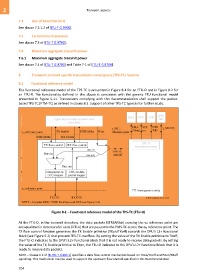Page 714 - 5G Basics - Core Network Aspects
P. 714
2 Transport aspects
7.4 Out-of-band PSD limit
See clause 7.2.1.2 of [ITU-T G.9700].
7.5 Termination impedance
See clause 7.3 of [ITU-T G.9700].
7.6 Maximum aggregate transmit power
7.6.1 Maximum aggregate transmit power
See clause 7.4 of [ITU-T G.9700] and Table 7-1 of [ITU-T G.9700].
8 Transport protocol specific transmission convergence (TPS-TC) function
8.1 Functional reference model
The functional reference model of the TPS-TC is presented in Figure 8-1 for an FTU-O and in Figure 8-2 for
an FTU-R. The functionality defined in this clause is consistent with the generic FTU functional model
presented in Figure 5-11. Transceivers complying with this Recommendation shall support the packet-
based TPS-TC (PTM-TC) as defined in clause 8.3. Support of other TPS-TC types is for further study.
Figure 8-1 – Functional reference model of the TPS-TC (FTU-O)
At the FTU-O, in the transmit direction, the data packets (STREAMds) crossing the γO reference point are
encapsulated in data transfer units (DTUs) that are passed to the PMS-TC across the αO reference point. The
TX flow control function generates the TX Enable primitive (TXon/TXoff) towards the DPU's L2+ functional
block (see Figure 5-2) that prevent TPS-TC overflow. By setting the value of the TX Enable primitive to TXoff,
the FTU-O indicates to the DPU's L2+ functional block that it is not ready to receive data packets. By setting
the value of the TX Enable primitive to TXon, the FTU-O indicates to the DPU's L2+ functional block that it is
ready to receive data packets.
NOTE – Clause 6.3 of [b-ITU-T G.999.1] specifies a data flow control mechanism based on TXon/TXoff and RXon/RXoff
signalling. This mechanism may be used to support the upstream flow control specified in this Recommendation.
704

